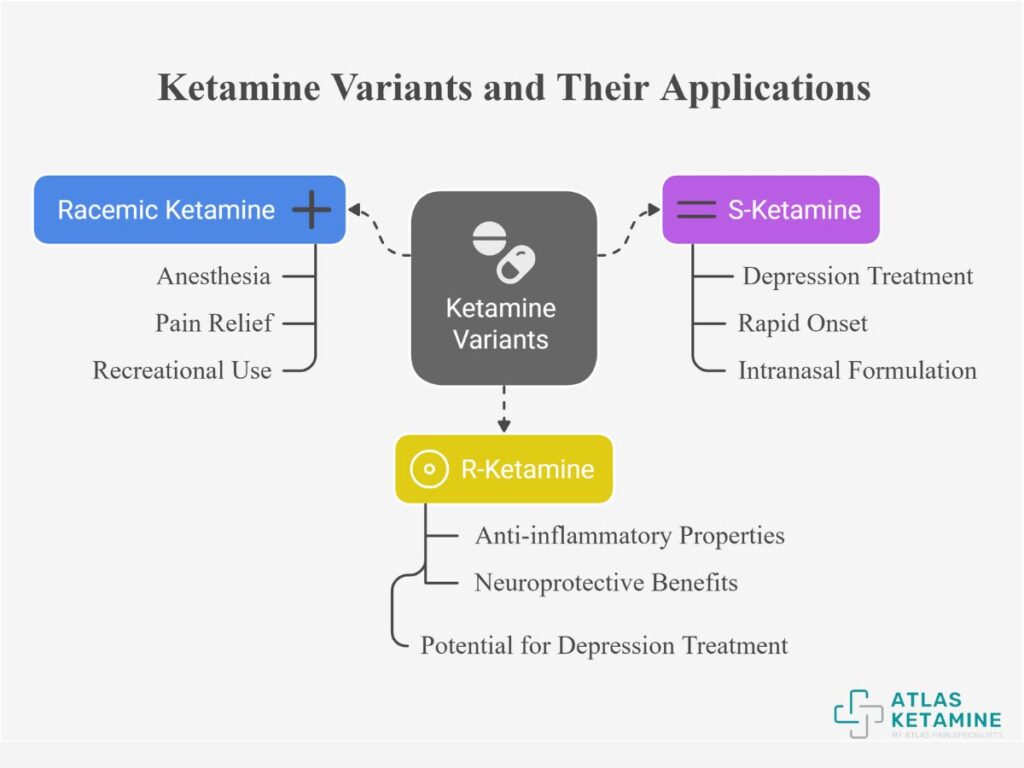Ketamine, a versatile NMDA receptor antagonist, is available in various forms with distinct uses. Racemic Ketamine (R,S-Ketamine) is a 50-50 mixture of R-ketamine and S-ketamine, commonly used as an anesthetic. S-Ketamine is used intranasally for depression treatment.
Other forms include Esketamine (nasal spray for depression), Intravenous (IV), Intramuscular (IM), Oral, and Subcutaneous administrations, each offering unique benefits and applications in medical and therapeutic settings.
Types of Ketamine
Ketamine is a dissociative anesthetic with various medical and potential therapeutic applications. It exists in different forms, each with unique properties and effects. The three primary types are racemic ketamine, S-ketamine, and R-ketamine. These forms differ in their composition, uses, and characteristics, making them suitable for different medical and research purposes.

Racemic Ketamine (R,S-Ketamine)
Racemic ketamine is a [50/50 mixture] of R(+) and S(-) ketamine. This combination balances the effects of both enantiomers, making it the most commonly used form of ketamine in clinical and anesthetic settings.
Uses:
Racemic ketamine is widely used for [anesthesia] and [pain relief]. Due to its dissociative properties, it is effective in emergency medicine, battlefield medicine, and surgeries where rapid sedation is required. It is also used in sub-anesthetic doses for chronic pain management and as an adjunct to opioid therapy, reducing the need for high opioid doses.
Beyond medical applications, racemic ketamine has been used recreationally due to its hallucinogenic and dissociative effects. However, its misuse raises concerns about dependency and cognitive impairment.
Forms:
Racemic ketamine is available in multiple [forms], including intravenous (IV), intramuscular (IM), oral, nasal, sublingual, rectal, and subcutaneous injections. The method of administration determines the onset and duration of effects, with IV providing the fastest and most controlled results, while oral and nasal forms offer more convenience but may have variable bioavailability.
S-Ketamine (Esketamine)
S-ketamine consists of [pure S(-) ketamine], making it more potent than its R-enantiomer. It has a higher affinity for NMDA receptors, which are involved in pain modulation and mood regulation.
Uses:
S-ketamine is primarily used in intranasal formulations for depression treatment. Approved by the FDA as a nasal spray (Spravato), it has shown rapid antidepressant effects in treatment-resistant depression (TRD). Unlike traditional antidepressants, which may take weeks to work, esketamine provides relief within hours to days.
Characteristics:
S-ketamine has a [shorter duration of action] and a [rapid onset], making it ideal for acute treatments. Its antidepressant effects are believed to stem from its ability to promote synaptic plasticity and enhance neural connectivity in the brain. However, due to its potential for dissociation and abuse, it is administered under medical supervision in a clinical setting.
R-Ketamine
R-ketamine consists of [pure R(+) ketamine]. Unlike S-ketamine, it has a lower affinity for NMDA receptors but exhibits unique pharmacological properties that make it a promising candidate for novel therapeutic applications.
Uses:
R-ketamine is being investigated for its anti-inflammatory properties and potential [therapeutic applications. Studies suggest that it may offer antidepressant effects similar to or even better than S-ketamine, with fewer dissociative and hallucinogenic side effects. R-ketamine has been explored for its neuroprotective benefits and its potential role in treating neurodegenerative disorders.
While research is still ongoing, R-ketamine’s distinct profile could make it a safer and more effective alternative for treating depression, inflammation, and chronic pain without the drawbacks associated with racemic and S-ketamine.
Characteristics:
R-ketamine has a longer duration of action]compared to S-ketamine and may produce antidepressant effects with fewer dissociative and hallucinogenic side effects. It also shows greater neuroplasticity enhancement, suggesting potential benefits in treating conditions like depression and neurodegenerative disorders.
Some studies indicate that R-ketamine provides [sustained antidepressant effects] with a lower risk of abuse and dependency. Additionally, its [anti-inflammatory properties] make it a promising candidate for treating chronic inflammatory conditions.
Forms of Ketamine Administration
Ketamine can be administered in multiple ways, each with unique characteristics that influence its effectiveness, duration, and safety. The choice of administration method depends on the intended use, whether for anesthesia, pain management, or psychiatric treatment.
Intravenous (IV) Ketamine
IV ketamine is widely used for [anesthesia], [rapid pain relief], and [depression treatment]. It is the preferred method in emergency and surgical settings due to its fast-acting properties.

Characteristics:
IV ketamine has a fast onset, typically within minutes, making it highly effective for acute pain management and psychiatric emergencies. It is administered under closely monitored clinical conditions to control dosage and minimize side effects.
This method ensures maximum bioavailability, as the drug bypasses the digestive system and enters directly into the bloodstream. However, due to its rapid effects, IV ketamine requires specialized medical supervision to prevent complications such as dissociation and blood pressure fluctuations.
Intramuscular (IM) Ketamine
IM ketamine provides effects similar to IV administration but offers a simpler [administration] process, as it does not require vein access. It is often used in emergency settings, pain management, and psychiatric treatments.

Characteristics:
IM ketamine has a slightly slower onset than IV ketamine, but it remains a fast-acting option. It is easier to administer, making it useful in pre-hospital settings.
However, it may cause [pain and bruising at the injection site], and the absorption rate can vary based on muscle mass and circulation. Despite these drawbacks, IM ketamine is a practical alternative when IV access is not available.
Oral Ketamine
Oral ketamine is used for [at-home treatment] of [mood disorders] and [chronic pain]. It provides a more convenient and less invasive method of administration.

Characteristics:
Oral ketamine has a [slower onset] due to digestive system absorption. It also has lower bioavailability compared to IV and IM administration, meaning a higher dose is often required to achieve therapeutic effects.
Despite this, oral ketamine has fewer side effects, making it a safer option for long-term use. It is commonly prescribed as a compounded lozenge or tablet for controlled dosing, particularly in depression and pain management.
Nasal Ketamine (Esketamine)
FDA-approved [nasal ketamine] (esketamine) is primarily used for [depression treatment] under strict medical supervision.

Characteristics:
Nasal ketamine has a rapid onset, typically within 20-40 minutes, and is administered in nasal spray form. This method allows for non-invasive administration while still providing relatively fast-acting effects. It is used in clinical settings to manage treatment-resistant depression, and due to its potential for dissociation and abuse, patients are monitored after administration.
Subcutaneous Ketamine Infusion
Subcutaneous ketamine is administered via [infusion] to provide slower administration with longer-lasting effects. It is commonly used for chronic pain conditions and some psychiatric applications.
Characteristics:
This method involves injecting ketamine under the skin, allowing for gradual absorption into the bloodstream. It provides sustained relief, reducing the need for frequent dosing.
Subcutaneous ketamine is often used in specialized pain management clinics to treat conditions like complex regional pain syndrome (CRPS) and fibromyalgia. Although its effects are prolonged, it requires medical supervision to ensure safe and effective dosing.
Therapeutic Applications
Ketamine has shown significant promise in various therapeutic applications, ranging from pain management to psychiatric treatment and anesthesia. Its unique mechanism of action on NMDA receptors makes it a valuable tool in modern medicine.
Pain Management
Ketamine is highly effective for both acute and chronic pain, often used as an adjunct treatment when conventional pain relievers fail. It works by blocking NMDA receptors, reducing central sensitization and preventing the development of chronic pain syndromes.
In acute pain settings, such as post-surgical recovery or trauma, ketamine is administered intravenously or intramuscularly for rapid relief. For chronic pain conditions like fibromyalgia, complex regional pain syndrome (CRPS), and neuropathic pain, lower doses are used in controlled settings to provide long-term relief and reduce opioid dependence.
Depression Treatment
Ketamine has gained recognition as a breakthrough treatment for [treatment-resistant depression] (TRD). Unlike traditional antidepressants, which may take weeks to show effects, ketamine produces rapid antidepressant benefits within hours to days. It works by promoting synaptic plasticity and enhancing neural connectivity, which is believed to help alleviate depressive symptoms.
Both racemic ketamine (IV infusion) and esketamine (nasal spray) are used in clinical settings under strict medical supervision. Research also suggests that ketamine may be effective for anxiety disorders, PTSD, and suicidal ideation, offering hope for individuals who have not responded to standard treatments.
Anesthesia
Ketamine has long been a staple in [medical settings] for surgeries and procedures. Its dissociative anesthetic properties provide profound pain relief and sedation while maintaining cardiovascular stability, making it a preferred choice in emergency medicine and battlefield settings.
Unlike other anesthetics, ketamine does not significantly depress respiratory function, making it particularly useful for patients with compromised breathing. It is also used in pediatric anesthesia due to its safety profile and ability to induce sedation without requiring mechanical ventilation.
How Long Does Ketamine Stay in Your System?
Understanding the different forms of ketamine is crucial for both medical professionals and individuals seeking treatment. From Racemic Ketamine to Esketamine, each type has its specific uses and benefits. For those interested in how ketamine's presence is detected over time, exploring how long ketamine stays in your system can provide valuable insights. This knowledge is essential for managing treatment plans and understanding the drug's effects. Visit our blog on "How Long Does Ketamine Stay in Your System?" for more detailed information on ketamine's duration in the body.
